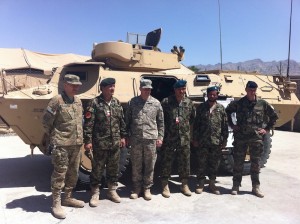SAO-A Trains and Equips the ANSF
There is an Afghan proverb that says “drops make a river.” We are trying to generate as many drops as possible. One of the sources of these drops is within our Security Assistance Office-Afghanistan (SAO-A). The staff of this office have an enormous job of managing the multitude of defense articles and services that the Afghans need in order to ensure they can take the lead in providing for the safety and security of their people and their country. SAO-A consists of four divisions staffed with just over 150 people.
Security Assistance Programs is responsible for generating the “drops” associated with the management of the procurement of defense articles and services through the foreign military sales process and for training Afghan students outside of Afghanistan under the U.S. International Military Education and Training Program, as well as other international training programs. A well led and equipped Afghan security force is a critical component of their future.
Another source of “drops” is through our local acquisition and contract management oversight office. This office is responsible for local procurement of defense articles and services, as well as tracking proper stewardship and oversight of all our service contracts. They manage our Afghan First program, which is designed to have Afghan businesses produce the materials required by the Afghan National Security Forces, including all of the uniforms used by the Afghan Army and Police. Some of the companies are both women owned and employers of only women workers.
Our security cooperation division is responsible for ministerial advising, as well as end-use monitoring of defense articles provided to the ANSF. We need the Afghans to be able to develop their own requirements, contract for their identified need and then manage its production, testing and ultimately, its fielding. The EUM team ensures and reinforces stewardship and accountability of critical material.
Our training program support office manages three of our largest services contracts (police training, army training, and ANSF vehicle maintenance). We recognized that we needed to ensure our accountability and stewardship of these critical contracts, so we formed an office to provide the appropriate degree of oversight.
So as you can see, our SAO-A office is critical to ensuring the Afghan Army and Police are equipped and trained to take the security lead of their country. This year alone, SAO-A purchased over $6 billion worth of equipment and training in support of the Afghans.
Between now and March 2012, we will deliver to the Afghan Army, Air Force and Police over 22,000 vehicles, 38 aircraft, over 50,000 pieces of communications equipment and almost 40,000 weapons. These are the enablers that will ensure the Afghan’s have the capacity to take the lead on security.
Getting this equipment here is the easy part. The harder par—and in my opinion, more critical element—is ensuring that we train the Afghans on how to operate and maintain this equipment. SAO-A has put in place training contracts that range from driver’s training to maintenance training. This ensures the Afghans can be good stewards of this equipment and can sustain it now and into the future.
We are focusing sufficient efforts this year to ensure that Afghans are prepared to be the trainers of their own soldiers and policemen. With our train-the-trainer program, the Afghans will be able to train their future generations of Afghan soldiers and policemen in many different career specialties. This internal training capability is a critical piece of our strategy to transition from NATO to Afghan led security.
A new addition to the Afghan Army inventory is the mobile strike force vehicle. This armored fighting vehicle is a significant enhancement to the Afghan Army’s inventory, and the first units will be fielded in early 2012. Training starts this fall at the Afghan Temporary Armor Branch School, and I look forward to sharing more with you about these units as they progress though their training cycle. For this week, I’ll leave you with a photo of the 1st mobile strike force commander with his staff during a recent planning meeting in Kabul.
HOOAH!
PETER N. FULLER
Maj. Gen., U.S. Army
Deputy Commander for Programs
NATO Training Mission – Afghanistan
Combined Security Transition Command – Afghanistan
Category: Blog - Leadership, Blog - Logistics, Blog – MG Peter N. Fuller, Blogs - Blogs

Comments (0)
Trackback URL | Comments RSS Feed
There are no comments yet. Why not be the first to speak your mind.